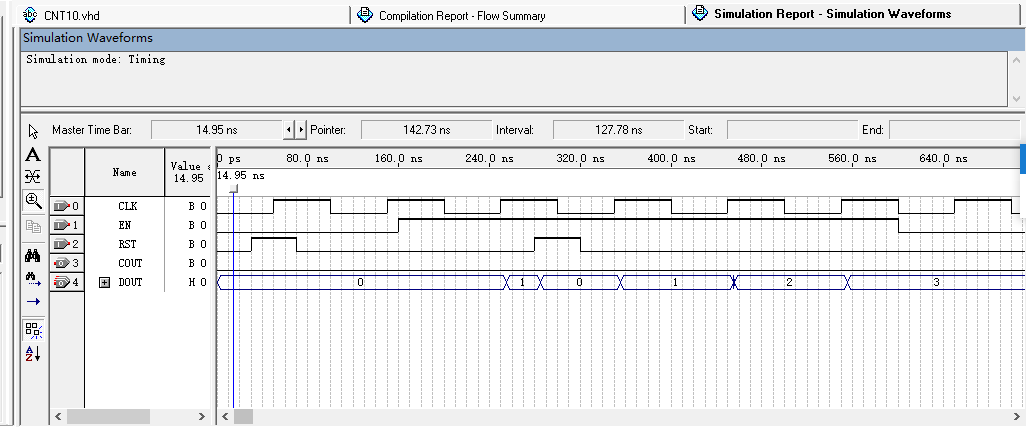一、异步复位加法计数器
代码:
library ieee; use ieee.std_logic_1164.all; use ieee.std_logic_unsigned.all; entity CNT10 is port( CLK,RST,EN: in std_logic; DOUT : out std_logic_vector (3 downto 0); COUT : OUT std_logic ); end CNT10; architecture behav of CNT10 is begin process(CLK,RST,EN) variable Q : std_logic_vector (3 downto 0); begin if RST = '1' then Q := (others => '0'); elsif CLK 'event and CLK = '1' then if EN = '1' then if Q < 9 then Q := Q + 1; else Q := (others => '0'); end if; end if; end if; if Q = "1001" then COUT <= '1'; else COUT <= '0'; end if; DOUT <= Q; end process; end behav;
仿真:

RST信号与CLK信号无关,随时可以置零
二、同步复位加法计数器
代码:
library ieee; use ieee.std_logic_1164.all; use ieee.std_logic_unsigned.all; entity CNT10 is port( CLK,RST,EN: in std_logic; DOUT : out std_logic_vector (3 downto 0); COUT : OUT std_logic ); end CNT10; architecture behav of CNT10 is begin process(CLK,RST,EN) variable Q : std_logic_vector (3 downto 0); begin if CLK 'event and CLK = '1' then if RST = '1' then Q := (others => '0'); else if EN = '1' then if Q < 9 then Q := Q + 1; else Q := (others => '0'); end if; end if; end if; end if; if Q = "1001" then COUT <= '1'; else COUT <= '0'; end if; DOUT <= Q; end process; end behav;
仿真:

RST信号只有等到CLK信号的下一个上升沿到时才能清零
三、总结
所谓“同步”是指与系统时钟同步。同步复位是指当复位信号有效时,并不立刻生效,而是要等到复位信号有效之后系统时钟的有效边沿到达时才会生效;
而异步复位则是立刻生效的,只要复位信号有效,无论系统时钟是怎样的,系统都会立即被复位。
在用VHDL描述复位信号时,在系统时钟有效边沿到达之后才判断同步复位是否有效;而对异步复位的判断则与系统时钟无关。
同步复位: IF clock'event AND clock='1' THEN IF reset='1' THEN -- 复位系统 ELSE -- 正常运作 END IF; END IF; 异步复位: IF reset='1' THEN -- 复位系统 ELSIF clock'event AND clock='1' THEN -- 正常运作 END IF;